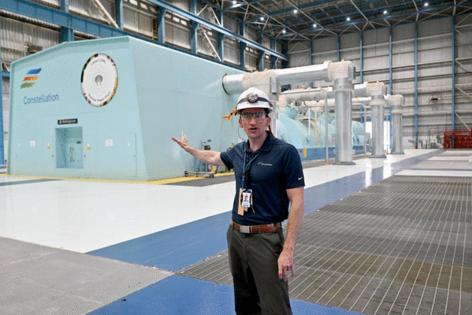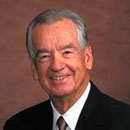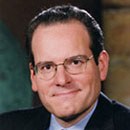From 'No Nukes' to Nuclear Now: The progressive energy flip
Published in Business News
A partial meltdown at Three Mile Island in Pennsylvania nearly 50 years ago pushed Gene Stilp into a life of activism, starting with a 1979 march on the Capitol he helped organize that drew 65,000 demonstrators and appearances by Joni Mitchell, Jackson Browne and Graham Nash.
At 75, Stilp is still at it — now protesting Baltimore-based Constellation’s plans to restart a reactor at the Harrisburg-area power plant, one not involved in the accident, in a deal with Microsoft. Stilp, who has lived nearby for decades, started Stop TMI Restart last fall. The group has about 32 members.
“We are two generations away from the accident that happened at Three Mile Island,” said Stilp, who accused Dauphin County, Pennsylvania, officials in an April lawsuit of failing to safeguard residents’ health and safety. “People have forgotten that nuclear power stands for dedicated dead zones with nuclear waste…People who are environmentalists have forgotten about all these things that their parents and their grandparents used to know. The new generations are not up to speed on nuclear power.”
But as Bob Dylan once sang, “the times they are a-changin.' ”
As Maryland and other states push for clean air amid rising power demand, advocates increasingly see nuclear energy as a key, cost-effective climate solution. Leading the push in Maryland is Democratic Governor Wes Moore, who is backing policies to support new technologies touted as safer, more efficient, and more versatile than traditional reactors.
Valerie Gardner, a California environmentalist, argued that anti-nuclear stalwarts are refusing to focus on the goals of reducing carbon emissions. She said that too many focus on renewables such as wind and solar while rejecting nuclear. The founder of the nearly 10-year-old Climate Coalition said she has come around, now taking on fights to keep nuclear plants open, including Diablo Canyon, California’s last nuclear power plant.
“It was just complete insanity and stupidity to try to close a large, reliable source of clean energy,” said Gardner, who called out anti-nuclear activists holding “30-year-old gripes” stemming from “fearmongering promulgated by groups to make the public afraid.”
“They lost the fight and the plants were built, but they continued to carry the flag all this time,” she said. “In its 68-year-old history, it’s the safest known energy we’ve ever had, with no pollution and fewer deaths” than those caused by fossil fuels.
Anti-nuclear movement evolved as officials look to lower costs, meet goals
The “No Nukes” movement that grew out of anti-war protests in the late 1960s has ebbed and flowed, expanding from weapons to energy and gaining followers after nuclear disasters such as Fukushima. Shortly after Stilp helped organizers of 1979’s Coalition Anti-Nuclear Rally in Washington, said to be the largest anti-nuclear protest at the time, Bruce Springsteen joined Musicians United for Safe Energy in the fall of 1979 for Madison Square Garden’s No Nukes concerts . By the mid-2000s, natural gas had gained favor as a cleaner, more plentiful energy source, causing investment in nuclear plants to decline.
In Maryland, bipartisan lawmakers have focused on rising energy costs and want to encourage new power generation in the state. Moore, who backs expanding nuclear, has said the state has not gone far enough to generate energy to hit its targets.
Moore said in mid-June some proposals that did not make it into energy bills would have “allowed more nuclear into the state, that would have allowed nuclear to be seen as a clean energy source, which it is,” adding “we need to be able to do more.”
Sen. Mary Beth Carrozza, a Republican member of the Education, Energy and the Environment Committee, sees opportunities to address the climate crisis as “more and more people understand nuclear energy is reliable, clean, and safe. There’s a recognition by … the general public that with the challenges we’re facing in Maryland with the energy crisis, we have to take an all-of-the-above approach. We cannot rely on wind and solar to make our goals.”
Groups like the Clean Air Task Force — founded in the late 1990s to highlight the dangers of coal power — are now pushing for nuclear energy policies in both the public and private sectors. Their focus is on lowering costs, speeding up development, and addressing challenges faced by older nuclear plants. The organization is exploring how state and federal governments can expand nuclear energy in the most cost-effective ways, including upgrading or restarting retired facilities.
Beyond renewable energy, such as wind and solar, it will take advanced nuclear, advanced geothermal and other technologies to achieve a 100% carbon free grid, said John Carlson, a senior regional policy manager for CATF, particularly given the needs of industries such as transportation and utilities looking to control costs for rate payers while meeting decarbonization goals.
“We see nuclear energy as a proven technology that can help meet climate and decarbonization goals in the United States,” said Victor Ibarra, senior manager for CATF’s advanced nuclear energy program. He said it will take “a wide suite of technologies beyond nuclear energy to effectively and efficiently produce the next electricity grid of tomorrow.”
Upgrades at plants in Maryland, elsewhere
John Phillippi, a nuclear engineer at Constellation’s Calvert Cliffs Nuclear Power Plant in Lusby, oversees the high-security plant as director of operations. The two-reactor facility, originally owned by Baltimore Gas & Electric, began operating in 1975 and 1977 and was rebranded Calvert Cliffs Clean Energy Center last year.
During a plant tour, Phillippi said Constellation is evaluating upgrading the plant to expand capacity — a highly costly and years-long process to plan for and rebuild the turbine and steam-producing side of the operation. Locking in long-term customers is one way Constellation and other nuclear operators have been able to do that.
Other types of modifications have altered Calvert Cliffs from its earliest days, making it more efficient, reliable and safer, he said. In the plant’s 24-hour control center, reactor operators monitor flat panel displays, touchscreens and automatic alarm functions. The right side of the room is dedicated to Unit 1, while a mirror image on the left side monitors Unit 2. Equipment in the center links to the switchyard, which controls power on its way to customers.
Thousands of data points filtered through computers and alarms “can detect changes in any of our systems that would alert the operators to an early indication of something they need to take action for,” Phillippi said.
Gardner, the founder of Climate Coalition, said it’s imperative to allow nuclear plants not only to stay open but expand like Calvert Cliffs. A technology entrepreneur, Gardner began to embrace nuclear after she’d spent tens of thousands of dollars in 2008 to install solar panels but her energy bills still weren’t covered.
“I began to realize, we can’t put this enormous [climate] crisis and its solutions on the backs of individual residents,” she said. When she found “two-thirds of all clean [power] came from nuclear, my jaw just dropped. I didn’t even imagine that nuclear was clean.”
Future of nuclear energy
Gardner said the “No Nuke” opposition to nuclear power may have shifted last year when Constellation signed a 20-year deal to supply electricity to Microsoft data centers in the mid-Atlantic by restarting Unit 1 at Three Mile Island, now known as the Crane Clean Energy Center.
“That news might have been the inflection point where people realized this anti-nuke thing is just wrong, and that arguments against nuclear are not based on fact, not based on data,” Gardner said.
Last month, Constellation signed a similar deal with Meta, the owner of Facebook, Instagram and WhatsApp, to power artificial intelligence technology with nuclear energy for 20 years at its Clinton Clean Energy Center in Clinton, Illinois – about 170 miles southeast of Chicago.
Those deals come amid growing demand for artificial intelligence that has big technology companies and data center operators rushing to lock in long-term clean power sources. Data centers require a consistent and steady electricity supply and have increasingly turned to nuclear for dedicated power.
Such deals continue to be opposed by activists, who argue electricity goes to far-off data centers, not consumers near a plant. Such groups include Harrisburg-based Three Mile Island Alert, which was founded in 1977, two years before Unit 2 came online and experienced a partial meltdown.
The partial meltdown, the worst nuclear power plant accident in the U.S., started about 4 a.m. March 28, 1979, with a mechanical or electrical failure in the non-nuclear section of the plant that prevented pumps from sending water to the steam generators, leading to a reactor shutdown, according to the U.S. Nuclear Regulatory Commission.
The NRC said small radioactive releases had no detectable health effects on workers or the public, but opponents have challenged findings in court.
Coincidentally, the 1979 film “The China Syndrome, depicting a nuclear accident, had been released just weeks earlier. It provided additional fodder for the “No Nukes” movement, along with another film,1983’s "Silkwood," based on the true story of a nuclear plant worker who was possibly murdered after raising concerns about radiation safety practices.
For its part, Three Mile Island Alert said its advocacy has brought about improvements in communication, security and evacuation plans. In its most recent battle, the group wants to stop Constellation’s plan to restart the plant’s Unit 1, which was restarted in 1985 and then shut down for economic reasons in 2019. TMI Alert advocates for the phasing out of both nuclear and fossil fuel power generation, arguing that enough renewable energy and storage projects are under consideration in the regional grid.
Eric Epstein, the group’s chair, said he has the same concerns now as 45 years ago.
“Nuclear power is an economic boondoggle,” Epstein said. “I thought then as I do now, there’s nowhere to store the waste. Nuclear has rebranded itself as renewable, which is crazy. The industry over time has subdued the public into believing that by putting green gift wrapping on toxic waste makes it an attractive alternative.”
©2025 The Baltimore Sun. Visit at baltimoresun.com. Distributed by Tribune Content Agency, LLC.












Comments